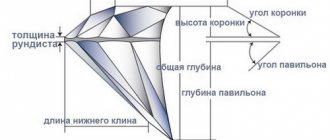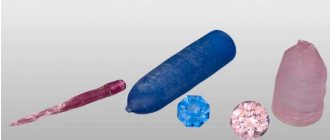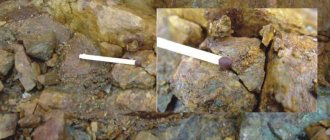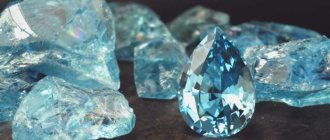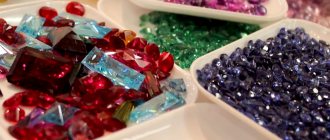Translation from the website of the Gemological Institute of America
Synthetic stone is a material that is synthesized in a laboratory.
At the same time, synthetic stone has almost all the chemical, optical and physical characteristics of its natural analogue mineral. In some cases, such as synthetic turquoise or synthetic opal, other compounds may additionally be present. Synthetic gemstone crystals were first produced in the late 1800s and their production most often satisfied the needs of various industries, but synthetic stones were not used in jewelry. The first success was achieved when it was possible to obtain a synthetic ruby that could be cut. Synthetic crystals are widely used in laser technology, communications, microelectronics and for the production of abrasive materials. Synthetic stones for jewelry can now be made “to order” (i.e., the appropriate color and crystal shape), taking the right ingredients and observing all the conditions for crystal synthesis. However, synthetic stones, of course, will not be as rare as natural stones of the same size, color, saturation and purity. Because there can be confusion and they can be mistaken for natural stones, there are strict rules on how they should be bought and sold.
In the United States, the Federal Trade Commission requires that any precious materials obtained in a laboratory be described differently than natural stones. If the origin of a synthetic gemstone at the time of sale is not transparently traced throughout the distribution channel from manufacturer to consumer, this is considered a serious violation and is classified as fraud. There are also a number of industry organizations such as the American Gem Trade Association (AGTA), the International Association of Colored Stones gemstones (ICA), and the World Confederation of Jewelery (CIBJO), which have also formulated specific recommendations for their members regarding the disclosure of the origin of synthetic stones when sold.
Over the past decade, fewer and fewer new types of man-made gemstones have entered the market. This suggests that the range of synthetic precious materials is close to reaching its limit, but it is not limited in production volume, which is still quite significant. Over the past century, researchers have developed a number of different ways to synthesize precious materials in the laboratory. Most of these methods fall into two main categories - melt or solution.
During crystallization from a melt, the chemical composition of the melt is the same as the composition of the resulting crystal. When synthesized from solution, the chemical composition of the solution or melt is different from that of the crystal. The constituent components are dissolved or melted at elevated temperatures and, after cooling, a crystal of a certain composition precipitates. The main methods of synthesizing stones:
Flame crystallization or Verneuil process (melting process)
The first commercially successful synthetic gemstones were created through a flame synthesis process. This process involves vertically passing powdered chemicals through a high-temperature flame, melting them in the flame and falling onto a rotating stand, where a synthetic crystal is formed. This is by far the least expensive and most common method of obtaining gemstones such as synthetic corundum and spinel.
Crystal pulling or Czochralski process (melting process)
The method originated in the early 1900s. The constituent substances are melted in a crucible and a synthetic crystal grows from a seed, which is immersed in the melt and then slowly pulled out of the melt as it grows. Synthetic alexandrites, chrysoberyls, corundums and garnets are grown in this way.
Flux growth (growth process from solution)
Today, some synthetic gemstones such as emerald, ruby, sapphire, alexandrite, and spinel are produced through a flux growth process. Flux is a solid material that, when molten, dissolves in other materials in the same way that water dissolves sugar. As the solution cools, the resulting synthetic crystals fall out.
Growing a synthetic gemstone this way requires patience and significant investment. Crystal growth can take up to one year, and the equipment is very expensive. But the results, especially when it comes to emeralds, are worth the time and effort.
Hydrothermal growth (solution growth process)
As with the previous method, the hydrothermal growing process is slow and expensive. But this is the only way to successfully grow synthetic quartz. It requires high temperature and pressure and mimics the natural processes that occur in nature deep in the earth that lead to the formation of natural gemstones. The starting substances are dissolved in water and synthetic crystals are formed when the solution cools.
In addition to the above, they also tried to synthesize other stones as an experiment, such as malachite, color-changing synthetic spinel and others. But nature produces these products more readily, so you don't often see such synthetics. Of the commonly found synthetic stones:
Synthetic diamonds
These lab-grown diamonds share most of the characteristics of their natural counterparts: they are essentially made of carbon.
Chemical vapor deposition (CVD) is the growth of diamond in a vacuum chamber through a chemical reaction that releases carbon atoms that are deposited on a diamond-seeded wafer.
Several synthetic diamonds produced by chemical vapor deposition (CVD).
Diamond growth using high pressure and high temperature (HPHT) is the growth of diamond from carbon dissolved in a flux melt followed by its deposition on seeds as the temperature decreases.
A collection of diamonds of various colors obtained using high pressure and high temperature.
Synthetic corundum
Synthetic corundum: ruby and sapphire, can be obtained by the largest number of processes. Therefore, synthetic corundum can cost differently: there are specimens both at a high price and at a very affordable one.
Synthetic corundum can be made in a variety of forms, including this colorful collection of flame crystallized crystals.
In the late 1800s, the ruby became the first gemstone created in the laboratory of Auguste Verneuil. In 1902, he announced the development of his flame crystallization process to synthesize this beautiful gemstone.
Synthetic ruby can be produced by flux growth (crystal and faceted stone on the left) and by flame crystallization (bullet and faceted stone on the right).
Some of the earliest synthetic sapphires are found as inserts in Art Nouveau and Art Deco jewelry. Many synthetic sapphires are still produced by flame crystallization. Flux-grown sapphires have been available since the 1960s. Flux grown, drawn and hydrothermal synthetic sapphires can be very convincing substitutes for natural gemstones. Color-changing synthetic sapphire, in imitation of alexandrite, has been popular since the early 1900s. The resulting inclusions cause a star-like appearance in some synthetic rubies and sapphires.
Synthetic sapphires can be crafted to exhibit asterism (star effect). Collection of sapphire cabochons.
Synthetic emerald and other beryls
Synthetic beryl is available in many colors, including yellow, red, blue (aquamarine) and green (emerald). In the late 1980s and 1990s, Russia became a major producer of these synthetic gemstones and is still a major supplier of hydrothermally grown gemstones such as synthetic beryl and synthetic corundum, as well as synthetic diamond and synthetic alexandrite.
Examples of synthetic beryl crystals and cut stones (including synthetic emerald in various green shades).
In the late 1930s, scientists finally developed a commercially viable method for producing emeralds that were preferably dark green in color. Synthetic hydrothermal emeralds for jewelry appeared on the scene in 1960.
Synthetic quartz
Good quality quartz stones such as citrine, rose quartz, smoky quartz, amethyst are very attractive. But natural gem-quality quartz is plentiful, so researchers have begun to develop synthesis methods not because the stones are rare, but because they play a key role in the technology. The use of quartz in high technology began in 1880, when the Pieri-Jacques Curie brothers discovered the piezoelectric effect in rock crystal - the property of crystals, when compressed, to create electric charges on the edges of their faces. It was also noted that if electric current pulses are applied to the edges of the faces, the crystals begin to deform somewhat, and when alternating current is supplied, they begin to vibrate. Moreover, it turned out that the frequency of vibration can be controlled by cutting plates from crystals of a certain shape. These virtues find practical application in optical instruments, in ultrasound generators, in telephone and radio equipment (as a piezoelectric), in electronic devices (“quartz” in technical slang is sometimes called a quartz resonator - a component of devices for stabilizing the frequency of electronic generators, in watches, communications .
Amethyst
Lab-grown amethyst and other varieties of synthetic quartz found their way into jewelry after being developed for industrial use. The first hydrothermal quartz appeared in laboratories in the 1890s. After World War II, synthetic quartz became widely available commercially.
Natural amethyst crystals and quartz rock crystal (left), and synthetic amethyst and synthetic rock crystal (right).
Synthetic spinel
At the beginning of the twentieth century, researchers tried to grow synthetic blue sapphire, but quite by accident they ended up with synthetic blue spinel. Since then, synthetic spinel has been widely used as a replacement for many natural stones. In the 1990s, Russia synthesized flux-grown synthetic spinels in a variety of colors, including red, a color difficult to produce using the old flame crystallization process.
Synthetic spinels are shown here as they are synthesized by the manufacturer. Faceted stones can be synthesized in any color and are often used to imitate other natural stones.
Synthetic opal
In 1970, Gilson developed a three-step process to produce synthetic opal. First, the deposition of microscopic spheres of silicon dioxide. Then keeping the resulting balls in an acidic aqueous environment for more than a year. Finally, hydrostatic pressure connects the spheres, stacking them on top of each other without deformation, creating the play of colors characteristic of opal.
Synthetic opals sometimes appear on the market and to the untrained eye they may appear to be quite valuable natural white and black opal.
Synthetic alexandrite
Natural alexandrite is rare enough to fully satisfy the demand for it. Therefore, over the past few decades, synthetic alexandrites have appeared on the market. Alexandrite has been synthesized using a number of different processes, including the Czochralski process, zone smelting, and flux growth. Additionally, color-changing synthetic corundum is often used to imitate natural alexandrite. In rare cases, color-changing spinel is found.
Synthetic alexandrites such as this stone (shown in incandescent and daylight) are rare. Less rare are alexandrite imitations, such as color-changing synthetic spinel and sapphire.
Translation from the website of the Gemological Institute of America
The jewelry industry uses special terms for artificially produced gemstones and their look-alikes: synthetic stone and simulant. The differences between the two are subtle but very important. Synthetic stone is made from different materials, but it has the same chemical composition as natural stone. It has the same crystal structure, optical and physical properties as a natural gemstone. However, there are also materials that simply look like natural gemstones. These products are called simulators or imitations, and can be of either natural or artificial origin. The old term for such materials is substitute.
Subtleties of classification
Jewelry stones, created not by nature, but by man, can be divided into synthetic (synthesized) and imitations. The first ones have a natural, real-life analogue and completely coincide with it in color, composition, hardness and other physical and chemical properties. For example, rubies, emeralds, diamonds, and sapphires can be natural or synthetic. Laboratory-grown stones gain commercially attractive weight in a matter of months, whereas in nature this process takes centuries.
The term “synthetic” in relation to “test tube” precious stones is considered unfortunate in the jewelry community, since consumers associate it with imitation and even counterfeiting. Jewelry with such stones, of course, has a more affordable price than with nuggets mined in mines and mines, but they cannot be called glass. By law, the manufacturer is required to indicate on the product label that the stone is artificially grown. You can distinguish synthesized stones from natural ones with the help of an examination at a gemological center, but not by eye.
Imitations are made from glass, minerals, metals, ceramics, and plastic. They have no natural analogue, since they were “invented” in laboratory conditions. Thus, neither Swarovski crystals nor cubic zirconia have any similarity in nature, although they are similar in appearance to rock crystal and even diamonds. Imitating jewelry inserts are used in the manufacture of costume jewelry and accessories (watches), less often in jewelry.
V) Chemical vapor deposition (CVD)
“CVD” is what we call “chemical vapor deposition.”
Chemical vapor deposition (CVD) is used today (2004) almost exclusively for diamond synthesis.
This method, developed by them or Apollo Diamond Inc, uses the activation of a mixture of methane (CH4) and hydrogen (H2) gases, with or without additions such as nitrogen (N2) or diborane (B2H6).
Activation of the vapor phase (transformation into plasma) occurs due to high temperatures generated by a microwave, filament or plasma torch.
The deposition of radicals (eg CH3) generated in this vapor phase occurs on a preformed natural or synthetic diamond substrate as a growth “seed” in the temperature range of 800 to 1000°C.
The diamonds thus formed show a development that is very different from natural or synthetic diamonds produced by HPHT.
These CVD synthetic diamonds can be any shade of brown as long as nitrogen is present in the vapor phase. This is the most common case encountered today because complete absence of nitrogen is difficult to achieve in this type of process. These brown diamonds may be more or less discolored.
The resulting single crystals can be completely colorless and extremely pure if only hydrogen and methane are used in the gas mixture.
But to obtain such results, the technique is still difficult to apply, and the growth time is much longer.
CVD diamonds can also be doped with boron (B) to create a type of diamond with shades ranging from pale grey-blue to fancy deep blue.
Diamonds obtained as a result of this CVD synthesis method have spectral and luminescent properties, as well as some growth defects specific to them, but these properties are often observed only when using expensive equipment.
However, this type of synthetic diamond, like HPHT stones, can be distinguished from natural diamonds using certain compact rapid testing devices such as DiamondSure.
There is no doubt that this technique, which is now increasingly being developed, has a bright future for the large-scale production of synthetic diamonds that can be used in jewelry.
Synthesized stones: a little history
The first synthetic stone, a 10-carat ruby, was obtained in 1891 by the French mineralogist Auguste Verneuil. Using the Verneuil method, it became possible to grow crystals suitable for jewelry use, and in 1910, synthetic sapphire was obtained in a similar way. An artificial emerald, identical to natural, was first grown in 1935.
But with girls’ best friends – diamonds – not everything is so simple. In 1954, in the laboratory of the American company General Electric, the first artificial diamond “ripened”, whose growth cycle could be repeated on an industrial scale. But it was a mineral of technical significance, not jewelry. Nowadays, the world annually produces millions of carats of diamonds and diamond chips for the needs of manufacturers of various instruments, devices, and instruments.
Gem-quality man-made diamonds were introduced by Herbert Strong and Robert Wentorf (both of General Electric) in 1970, but analogues have failed to flood the jewelry market today. The process of growing king stones is long, complex and expensive compared to other laboratory-produced gems. A diamond cut from a synthetic crystal can cost from 50% to 90% of the price of a natural nugget of similar weight and processing, or even exceed its cost. According to scientists, this direction is the future, but for now there is no need to fear that real diamonds in jewelry will be replaced by grown ones.
II) Solution-melt method
This method involves crystal components that must be prepared in a solution that does not contain water. To synthesize emeralds, lithium, lead, vanadium molybdates, etc. are used as flux.
In some anhydrous processes, crystals form as a result of spontaneous germination in the flow.
Thus, this process involves, using the example of emerald: the constituents of beryllium, i.e. beryllium oxide, aluminum oxide, silicon oxide (silicon oxide) and chromium salt as a chromophore agent, which are placed in solution at high temperature in a bath of molten salts forming a “stream” (molybdates, anhydrides, etc.).
The ingredients are thus mixed and melted at a temperature of approximately 800°C - 1000°C in a platinum crucible, then cooled slowly and in a controlled manner over the natural crystalline seed material (except in the case of spontaneous germination).
Once the contents of the crucible are dissolved, crystals are produced, the sizes of which depend on the amount of compound material initially introduced, the time and the temperature gradient used for melting and cooling.
This process (sometimes incorrectly called diffusion treatment) is actually associated with synthetic stones. Indeed, some colorless or low-grade corundums can be used as seeds in the synthesis process. This creates a large stone with a thin layer of colored synthetic corundum around it (sapphire ruby, etc.).
Various manufacturing procedures are often named after the scientist who developed them or the company that uses and sells the stones resulting from the process.
Imitation inserts: a little history
The most popular imitations of precious and semi-precious stones in jewelry are cubic zirconia and Swarovski crystals (rhinestones). Remember, cubic zirconia is not an artificial diamond! It does not contain carbon, the main element for diamonds, but contains zirconium oxide. Cubic zirconia was obtained in the mid-1960s by scientists at the P. I. Lebedev Physical Institute of the USSR Academy of Sciences (FIAN), after whom it was named.
The idea of imitating diamonds using cut lead glass was invented in the 18th century by glassmaker and jeweler with German roots, Georg Strass, who lived in French Alsace. The master’s surname became the name of his invention: the spectacular inserts were called “rhinestones.” A century later, Strass's ideas were developed by Daniel Swarovski, a hereditary cutter of Bohemian crystal. He improved the composition of rhinestones, the quality of polishing and the durability of spraying, so that they were not inferior to diamonds in the beauty of cut, transparency, play of light and brilliance. In 1895, Daniel founded the Swarovski company in Austria to sell his products to the whole world and primarily to fashion designers in Paris. The business of the talented cutter, inventor of the first electric cutting machine (1892), thanks to the efforts of his descendants, continues to flourish today. Swarovski crystals (rhinestones) have 12 facets, are made from high-quality crystal (glass with 32% lead oxide content) with the addition of powdered synthetic and natural stones of jewelry value.
VI) Sedimentation
Sedimentation is most often used to synthesize opal and involves (in the case of noble opal synthesis) a chemical reaction with silicic acid, resulting in the formation of silicon elements, which then remain permanently in the sedimentary layer.
Amorphous hydrated elements from silicon are organized into ordered layers, which ultimately give the most valuable play of color. The reaction solvents (alcohols) must be allowed to evaporate very slowly.
In this process, during drying, the silicon grains, under the influence of stress, are organized into groups (clusters), which give an effect known as “lizard skin”, observed under magnification. Opals were first prepared in this way by French chemist Pierre Gilson in the 1970s.
There are other “recipes” for the synthesis of noble opal.
Some syntheses, involving compounds such as zirconia (ZrO2) and most likely a thermal process, often have a columnar appearance, and can be considered almost like a type of ceramic.
Why are synthetic stones and imitations needed?
First of all, “substitutes” for precious stones are good because they make jewelry more affordable. Buying a ring with an artificially grown emerald without spending too much for your own budget or saving money for several months for beauty created by nature is everyone’s personal choice. And those who do not need to save up to purchase jewelry masterpieces prefer to wear inexpensive copies of jewelry outside of red carpets and gala dinners. An example is Beyoncé, whose engagement ring with an 18-carat diamond is valued at $5 million: for every day, the singer has a copy of this ring, which costs 1,000 times less - $5,000.
Also, the “alternative to luxury” fits into the global eco-trend - concern for preserving the environment, since the deposits of some precious stones are close to depletion these days.
And finally, it is much easier to obtain ideal characteristics from a grown stone in terms of carat weight, color, light refraction, and the absence of any defects - inclusions, microcracks, etc. There are laboratory centers for the production of synthetic stones in Russia, China, India, the USA, Sweden and other countries of the world.
III) Hydrothermal synthesis method
At high temperatures and pressures, water (more precisely, elemental or acidic solutions) can behave as a solvent for mineral species. This phenomenon, close to nature, is used to obtain crystals of very high purity by placing them in an autoclave.
An aqueous solution in an autoclave-type stainless steel cylinder (sometimes coated with precious metals such as platinum, gold or iridium) containing silicon (at the top or bottom of the cylinder depending on the option) and nutrients at the bottom of the cylinder is heated in the event of synthesis emeralds in the range of 350-600°C and under pressure from 250 to 1500 kg/cm2.
Crystallization occurs around the seed crystal due to a temperature change (about 10°C) between the bottom and top of the cylinder.
Convection movements of the fluid transport the heaviest components to the top of the cylinder. The fact that the top of the cylinder is less hot results in a cooling effect that directs the convection movement of the solution towards the center and bottom of the cylinder and thus towards the seed crystal. This is how it grows.
The conditions in this process can be compared to those in natural deposits, although they differ significantly in the absence of carbon dioxide, which plays a very important role in natural deposits.
The crystals produced in this way are especially pure and sometimes very large in size.
Chemical reaction
Chinese scientists have managed to synthesize large microparticles of high-quality diamonds from carbon dioxide (using sodium metal at a temperature of 440°C and a pressure of 800 atmospheres in an autoclave).
The gemstones synthesized in this way were tested by Raman spectroscopic and X-ray diffraction instruments. Scanning electron microscopy showed that these diamond particles range in size from 10 to 250 microns. Under an optical microscope, these diamonds appear colorless and transparent.
The resulting cubic diamonds are of very high quality, and at this relatively low temperature, this method can be used to make large gemstones with CO2 as a directly available carbon source.
More detailed information can be found at https://www.geminterest.com/synthese.php


